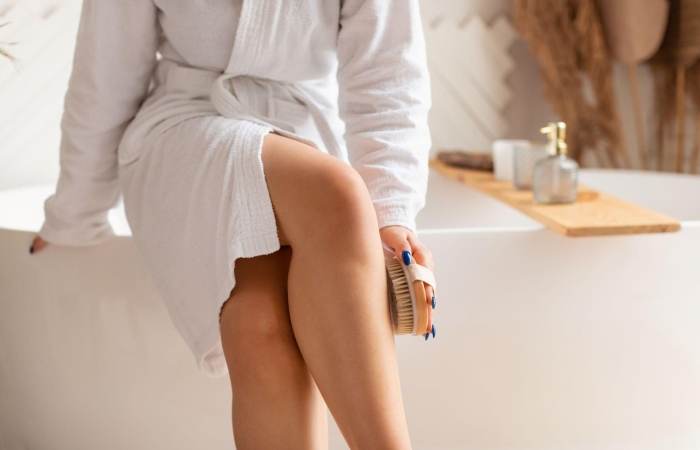Share This Article
Introduction
Skin Brushing – Dry brushing works by peeling the skin. Practitioners of the dry brush rub a brush with coarse natural fiber bristles in a specific pattern over their body. The idea is that the coarse fibers help remove dead skin and improve the skin’s ability to release toxins through pores.
The gentle brushing of the skin is a form of physical peeling, which means that dead Skin Brushing can be removed and makes it look smoother. If you peel on dry skin, the friction is compared to the skin.
How Many Times a Week You Should Brush Your Skin?
However, as a general rule, Downie recommends brushing dry no more than once or twice a week. And don’t forget to wash your brush with baby shampoo at least twice a month to eliminate all that dead skin buildup. Skin Brushing If you have an ultra-sensitive reproduction, try brushing yourself dry every few weeks.
What is Dry Brushing?

Skin Brushing – Dry-brushing is a centuries-old form of Ayurvedic medicine. It is thought to have many health benefits. Some of the benefits may include:
- Stimulating the lymphatic system
- Game exfoliation
- Helps the body destroy toxins
- Increase blood flow and energy.
- Peeling
- Helps reduce cellulite
Dry brushing works by exfoliating the skin. Dry-brushing practitioners rub a brush with thick bristles of natural fiber over their bodies in a specific pattern.
The idea is that profuse fibers help remove dead skin and recover the skin’s aptitude to expel toxins through pores.
What are the Advantages of Skin Brushing?
Skin Brushing – Dry brushing can help your body release toxins. It can also help you relax. There is a little evidence to show the benefits of dry brushing, but it does little harm to most people to practice dry brushing. There is little scientific evidence of the benefits of dry brushing. But there is anecdotal evidence. Possible benefits include:
Lymphatic System and Removal of Toxins

It assists your body in avoiding infections. Liquids flow through the procedure and are filtered through the lymph nodes. However, the technique may become clogged if sick or bare to toxins. That’s why your lymph nodes are often plentiful when you become a cold.
Dry brushing is hypothetical to assist the body in releasing toxins and finished sweat. This is because the uneven bristles of the brush stimulate the pores and open them. This makes the body sweat more professionally, reducing toxins flowing through the lymphatic system.
There is a little research to support this claim.
Peeling
The coarse bristles can remove dry, dead skin patches from the skin. This will make your skin smoother and softer.
Relaxation
Similar to a massage, you can relax while brushing dry. Practice dry brushing in a dark, quiet place to make the most of this advantage.
Cellulitis
cellulite is a disease that affects mainly women. Areas affected by cellulite have a corrugated or “cottage cheese” appearance. The cause is not fully known.
A massage has been shown to reduce the occurrence of cellulite temporarily. In addition, some claim that dry brushing can decrease the appearance of cellulite, as it has the same effects on the body as a massage. However, no scientific data supports this theory, and most physicians do not know it as a treatment.
“[dry brushing] peels, which is fine if it is not carried out too vigorously,” said dr. Carolyn Jacobs, a state-certified dermatologist and director of Chicago cosmetic surgery and dermatology. “but it does not help against cellulite, as this is due to the fat and collagen ligaments in women.”
How to Brush Your Dry Face Correctly

Some people believe that dry brushing can help drain lymph under the skin and detoxify the body. Skin Brushing to brush your face correctly, follow these steps:
1. Use the Right Tool
Start with the right tool (see “Where Can I Find a Dry Brush” below) and a clean for dry skin.
2. Start from the Forehead.
Work from the forehead of your face and down to your heart. Start brushing your forehead from the bridge of your nose toward the hairline and repeat in the opposite direction on the other side of your face.
3. Move To Your Cheekbones
Move to your cheekbones and lower to your chin with gentle movements. Try to move the brush slowly and deliberately and apply gentle pressure.
4. Wipe Your Face
After brushing your face, use warm water to clean any dandruff left on your skin.
5. Apply a Moisturizer
Apply a moisturizing serum or lotion to the face as the final step after dry brushing.
Also Read: Prima Belle Skin Serum Reviews

